We've independently reviewed this article to make sure it's as accurate as we can make it.
To find out more about our article creation and review process, check out our editorial guidelines.
Stuck trying to figure out why your dryer keeps tripping your circuit breaker?
That sucks! I know how annoying it can be to try to dry your clothes and have your breakers trip all the time. After all, dryers should make our lives easier, not harder.
Luckily, you’ve come to the right place for answers. Below, you’ll find a list of the 6 most common causes behind a dryer that keeps tripping your circuit breaker so that you can get everything back on track quickly.
When your dryer keeps tripping your breaker, chances are the breaker itself may be weak, the appliance has a short, or a component is drawing more amps than it should. The issue could also be related to a faulty power cord/heating element or a damaged drive motor.
Ready? Let’s get to work!
Why trust us? This article was written by Craig Anderson and Andy Fulenchek.
Craig has helped thousands of other homeowners repair their appliances since 2016.
Andy is one of our resident appliance repair experts with over a decade of experience. He currently runs his appliance repair company with a team of trusted technicians.
6 Reasons Why Your Dryer Keeps Tripping Your Circuit Breaker (With Fixes)
#1 A Damaged Power Cord/Wall Outlet
I tend to find that one of the most common causes behind a dryer that keeps tripping your breaker is a damaged power cord/wall outlet.
Dyer power cords are sturdy and built to last, but they can wear out over time and cause problems. If your dryer keeps tripping your circuit breakers immediately after you plug it into the wall outlet, chances are either the appliance or the outlet is at fault. Provided the dryer runs for a while and then stops, you’ll have to look elsewhere.
You can try plugging the washer into a different power outlet, and if your breakers are still tripping, the cord is likely the culprit. More often than not, an exposed wire from the cord is touching the dryer’s frame, causing an immediate short circuit.
In cases of a bad power cord, my usual advice is to look for a replacement. Thankfully, replacement power cords are typically cheap and easy to install.
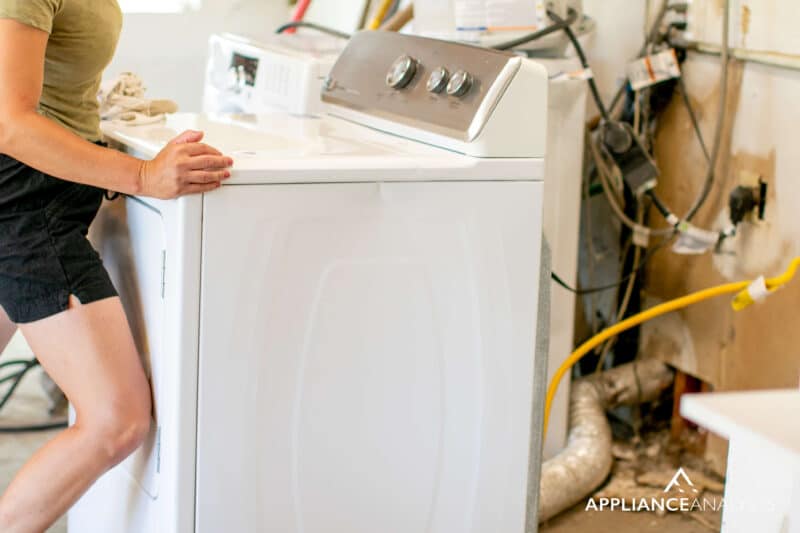
Tip: Sometimes, before you experience tripped breakers, you can spot other symptoms of a bad power cord, as your dryer might not heat up or might smell a little like burning.
#2 A Faulty Heating Element
If the power cord and the wall outlet seem ok, the next component to look at is the heating element.
The heating element is what heats the air that circulates through the drum of the dryer. If the element is defective, it could potentially short out its housing, resulting in the dryer tripping the breaker.
To tell whether the heating element is faulty, use a multimeter tool to check for continuity:
- Turn off the power to the dryer.
- Pull the dryer out from the wall/cabinet and remove the panels so you can access the heating element. Your owner’s manual can show you the location of the heating element, as the location differs based on brand and model.
Once you locate the heating element, use the multimeter to test each terminal for continuity. If there’s no continuity, the heating element is faulty and must be replaced.
In the event the heating element in the dryer passes the continuity test, please keep reading.
#3 Shorted to Ground Element
Another possible reason your dryer keeps tripping your circuit breaker is that a broken element or a loose wire is coming into contact with the appliance’s metal frame.
Many elements inside dryers (such as the heating element) tend to break and pop off their place when there’s a short circuit. The popping often results in the elements touching something metal, which is the perfect recipe for tripped breakers.
And the same goes for loose/peeled wires, as their rubber housings can break over time and start touching the dryer’s metal frame as well. You must identify the grounding issue and replace the broken component/wire to address the situation.
If you want to get any replacement part – or see how much one would cost – click to enter your model number in the search bar below. Our partners at AppliancePartsPros stock almost every part with free guides on how to install them.

#4 An Internal Short
If your issue isn’t with any of the elements above, it may be an internal short causing the dryer to trip the breaker.
Many components inside your dryer could cause an internal short, such as a faulty door switch, a defective timer, a bad motor, and even the on/off switch failing to operate properly.
A multimeter can be used to test each of the components mentioned above to determine if they’re good or if there is a shortage in one of them. If you find a faulty component, it will need to be repaired or replaced.

One tip to identify which component or wiring circuit is causing the breaker to trip is to isolate each circuit branch by unplugging suspected components from the dryer.
#5 A Failing Drive Motor
If your dryer keeps tripping your circuit breakers, there’s also a chance that the drive motor is failing. While rare, a drive motor can fail and start to short out internally.
To tell whether the drive motor is your issue, switch off the power to the dryer and remove the front and back panels so you can access the part.
Locate the drive motor, and use a multimeter to test the component for continuity and short ground as you did with the heating element and heating element assembly.
If there are signs of damage, the drive motor must be replaced. If the drive motor is fine, then check the next dryer component on the list.
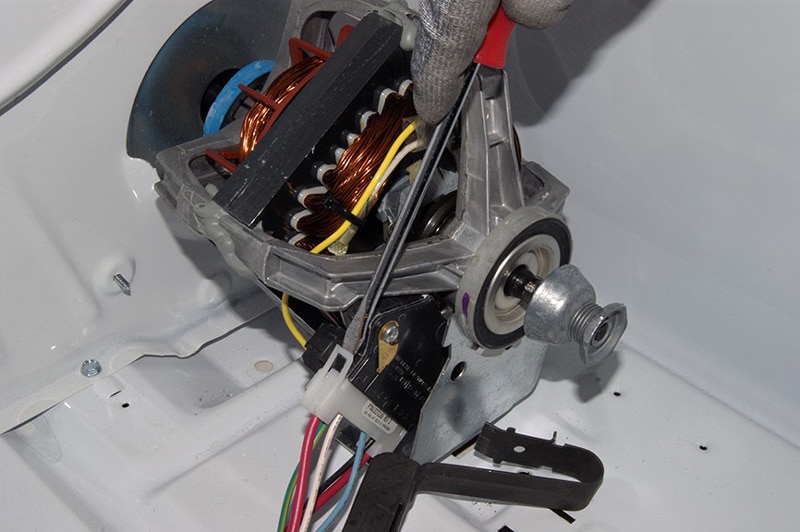
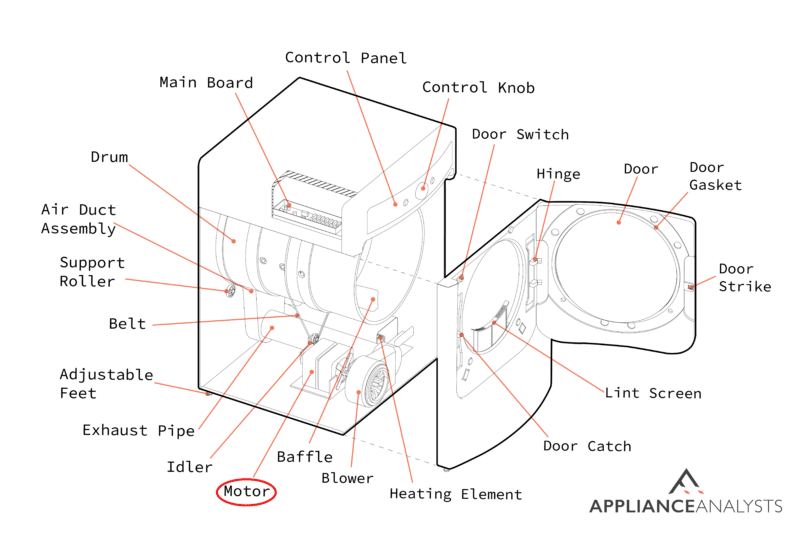
#6 A Weak Circuit Breaker
Before diving into this section, it should be noted that bad breakers are typically more common in older homes, as newer breaker models are built to handle higher currents and amperage. So, if your home is newer than 20-30 years old, you’re probably ok.
Provided you do live in an older home, there’s a good chance that the problem you’re experiencing can be due to a weak circuit breaker and have nothing to do with your dryer.
Circuit breakers suffer wear and tear over time, making them weaker and more prone to failure. As a result, your breakers might not be as good at dealing with power surges as they once were. And when breakers start acting up, my usual advice is to have them replaced.
To address the situation, an amperage meter can be used to test your circuit breaker while your dryer is turned on and running.
Please use extreme caution when testing wiring and circuit breakers. If at any point you feel uncomfortable or uncertain, I strongly recommend stopping and calling a professional electrician.
Safety first!
During testing, the amperage reading should not be above 30. Anything over 30 indicates your circuit breaker is potentially weak and requires replacement.
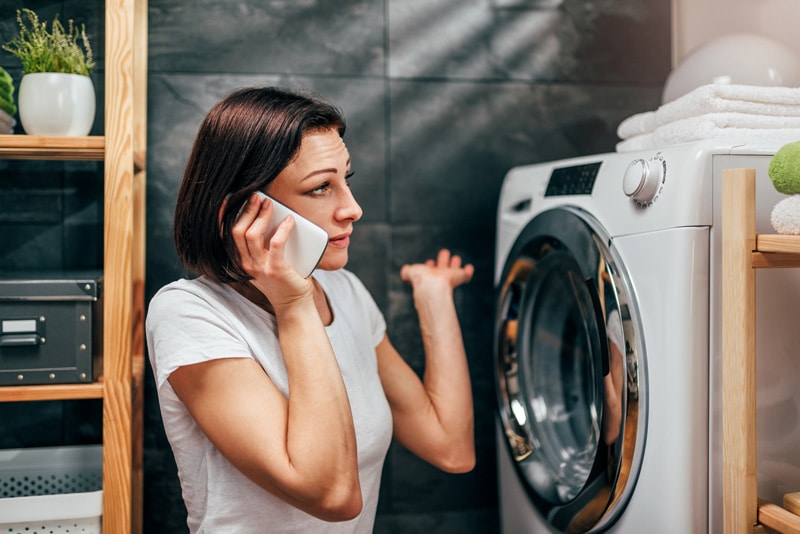
Conclusion
Hopefully, by the end of this article, you’ll have successfully found the solution for a dryer that keeps tripping your breakers.
More often than not, it will be one of the six reasons listed above. If, for whatever reason, it’s not, you’ll need to reach out to a professional for further assistance, as there could be a more serious underlying cause for what you’re currently experiencing.
Thanks for reading. If you enjoyed this article and learned something new, please consider checking out our other resources below and subscribing to our newsletter.
Have a great week!
-Craig.






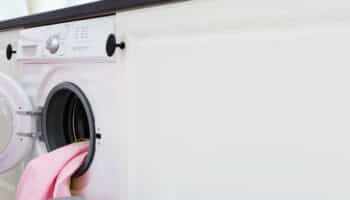
![LG Dryers: How to Change the Temperature [Easy Guide]](https://applianceanalysts.com/wp-content/uploads/2022/11/Featured-LG-Dryers-How-to-Change-the-Temperature-350x200.jpg)
